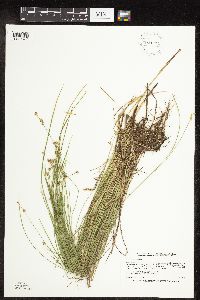Carex interior
|
|
|
|
Family: Cyperaceae
Inland Sedge
[Carex interior f. keweenawensis F.J. Herm., moreCarex interior subsp. charlestonensis , Carex interior var. keweenawensis , Carex scirpoides Sartwell, Carex stellulata var. scirpoides (Rchb.) Darl.] |
Culms 10-95 cm. Leaves 3-5 per culm; sheaths tight, inner band hyaline, 1.8-13 cm, apex concave, glabrous; ligule of distalmost leaf obtuse to rounded, 0.6-2.2 mm; blades plicate, 6-31 cm × 0.6-2.4(-2.7) mm, widest leaf 1-2.4(-2.7) mm wide. Inflorescences 0.8-3.7 cm; spikes 2-5(-7); lateral spikes pistillate often with few staminate flowers proximally, 3-9.5 mm, sessile, staminate portion 3-flowered, to 2.2 mm, pistillate portion 3-18-flowered, 2.3-8 mm; basal 2 spikes 2.1-11 mm apart; terminal spike 5.2-20 mm, gynecandrous, staminate portion 3-10-flowered, 2.2-14.5 × 0.7-1.4 mm, pistillate portion 4-16-flowered, 3-7 × 4-5.8 mm. Pistillate scales ovate, 1.2-2.1(-2.4) × 1-1.6 mm, apex obtuse. Staminate scales ovate, 1.4-2.9 × 1-1.3 mm, base clavate, apex obtuse to acute. Anthers 0.6-1.4 mm. Perigynia spreading to reflexed, castaneous to dark brown, 4-12-veined abaxially, sometimes faintly, 0(-6)-veined adaxially over achene, ovate, often convexly tapered from widest point to beak, forming a 'shoulder,' 1.95-3(-3.3) × 1.1-1.8 mm, 1.4-2(-2.2) times as long as wide; beak 0.4-0.95 mm, 0.18-0.44 length of body, setulose-serrulate, teeth 0.15-0.4 mm. Achenes ovate, 1.2-1.8 × 0.95-1.5 mm. Fruiting late spring-early summer. Wet meadows, wet prairies, fens, coniferous and deciduous swamps, river and lakeshores, seeps; usually in ± calcareous, open sites; 0-2700 m; St. Pierre and Miquelon; Alta., B.C., Man., N.B., Nfld. and Labr. (Nfld.), N.W.T., N.S., Ont., P.E.I., Que., Sask., Yukon; Alaska, Ariz., Ark., Calif., Colo., Conn., Idaho, Ill., Ind., Iowa, Kans., Maine, Mass., Mich., Minn., Mo., Mont., Nebr., Nev., N.H., N.J., N.Y., N.Dak., Ohio, Oreg., Pa., S.Dak., Utah, Vt., Va., W.Va., Wash., Wis., Wyo.; Mexico (Chihuahua). When Carex interior occurs with C. sterilis, C. echinata, and (rarely) C. atlantica, usually sterile intermediates, presumably hybrids, may occasionally be found.
Cronquist et al. 1977 Common Name: inland sedge Duration: Perennial Nativity: Native Lifeform: Graminoid General: Densely tufted, with slender stems 20-50 cm tall, leaves reduced above. Vegetative: Leaves all borne together on the lower part of the stem, not closely bunched, can equal the stems, flat and 1-2 mm wide. Inflorescence: Spikes mostly 3-6, sessile, small and few flowered, some of the lateral spikes wholly pistillate, but the terminal one with a conspicuous, slender, staminate base, the bracts small and inconspicuous, shorter than the perigynia and hyaline or scarious except for the firmer greenish midvein, the perigynia 5-15 per spike, crowded, lower ones reflexed, broadest near the base, ovate to triangular, coriaceous and shining, thickened at base, 4-12 nerves on back, plano-convex, with raised marginal nerves, serrulate margined near tips and on beak, beak less than 1 mm long, fourth to half as long as body, achene lenticular about 1.5 mm long. Ecology: Found in swamps, bogs, along creeks and streams, and in other wet locations from sea level to 9,000 ft (2743 m), flowers April-June. Distribution: Ranges throughout the interior west, north to Canada and south into northern Mexico. Ethnobotany: Unknown Etymology: Carex is the classical Latin name for the genus, while interior means inside or inland. Synonyms: Carex scirpoides Editor: SBuckley 2012 Stems tufted, aphyllopodic, 2-9 dm, smooth; lvs 3-5 per stem, all in the basal third, shorter than to about equaling the stems, plicate, 1-2.5 mm wide; spikes (2)3-6, sessile, contiguous or ±remote, small and few-fld, the terminal one with a conspicuous, slender, staminate base, some of the lateral ones often wholly pistillate; bracts small and inconspicuous; anthers 0.6-1.4 mm; perigynia mostly 5-15, crowded, widely spreading or the lower reflexed, green or tan, planoconvex, coriaceous and shining, spongy-thickened at base, 4-12-nerved dorsally, nerveless or occasionally few-nerved ventrally, ovate or triangular-ovate, 2.2-3.2 נ1.1-1.8 mm, 1.4-2 times as long as wide, tending to be ±convexly tapered from the widest point to the beak, conspicuously serrulate-margined distally and on the beak, this short, broad, very shallowly bidentate, 0.5-1 mm, a fourth to half as long as the body; achene lenticular; 2n=54. Swamps, bogs, and other wet places; Nf. and Lab. to s. Yukon and Alas., s. to Va., Mo., and Mex. Gleason, Henry A. & Cronquist, Arthur J. 1991. Manual of vascular plants of northeastern United States and adjacent Canada. lxxv + 910 pp. ©The New York Botanical Garden. All rights reserved. Used by permission. From Flora of Indiana (1940) by Charles C. Deam Frequent to common except in southern Indiana; in tamarack bogs and swamps and on springy banks. ...... Indiana Coefficient of Conservatism: C = 8 Wetland Indicator Status: OBL |
|
|
|

































































































